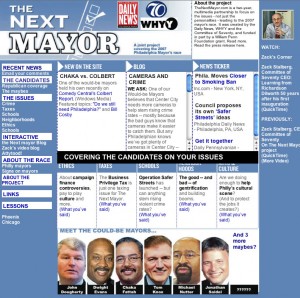 Start Here |
 Ch. 1: Funding Fit |
 Ch. 2: Impact |
 Ch. 3: Success |
 Search Database |
 See Videos |
Chapter 2: News with Civic Impact
When Philadelphians were tasked with electing a new mayor in 2007, there was uneasiness in both the local journalism and foundation worlds.
City races were known to be dirty, often with racial overtones, and people tended to cast their votes based on where they lived or worked. Candidates could say one thing in North Philadelphia and another in Center City and get away with it.

TheNextMayor.com provided robust coverage of Philadelphia’s 2007 mayoral race.
So when two news outlets and a good-government group approached The William Penn Foundation with an idea for an interactive election project, the foundation was receptive. “It looked like a great opportunity for us to make sure that the mayoral campaign had the content and the excitement and the accuracy that we were not confident could happen otherwise,” said Feather Houstoun, the foundation’s president.
The project’s influence on the community turned out to be eye opening - not only to the news partners but to the funder as well. The Next Mayor, like many news and information projects now cropping up around the country, had a robust civic impact.
In Philadelphia, project partners listened to voters, cataloged their concerns, redefined issues, tracked every candidate, posted every press release, blogged and YouTubed. Then, in the countdown to Election Day, traffic to their Web site, TheNextMayor.com, skyrocketed. (The site is no longer available online.)
Voters “had to go to the Web site and figure out who to vote for,” said Wendy Warren, who spearheaded the project as a then-top editor at the Philadelphia Daily News.
The impact of the New Haven Independent is “about how the content and the dialogue produced by the content - the interactive nature - is shaping public response.”
— William Ginsberg, president of The Community Foundation for Greater New Haven
So comprehensive was The Next Mayor that candidates had to be consistent. “I think one of the best surprises and perhaps the biggest one was … that the candidates couldn’t triangulate among all the different neighborhoods,” Houstoun said. “They couldn’t say one thing at a policy forum about arts and culture and then dismiss arts and culture when they went to another part of town. Because it was all right there on the Web page.”
The project’s influence, moreover, continued to ripple through the community long after the new mayor took office. Two years later, many of the ethics recommendations that The Committee of Seventy urged candidates to endorse were actually being put into practice, said Zack Stalberg, the good-government group’s president and CEO.
As more and more community media start-ups emerge to supply or supplement local news, they are affecting more than just their communities’ media ecosystems. Their news and information are boosting voter turnout, unseating incumbents, expanding attendance at community meetings and spotlighting issues early enough for residents to have greater and better input.
- New Haven, Conn., early attention paid to local housing foreclosures by the New Haven Independent prompted the mayor to appoint a task force long before the bottom fell out of the mortgage market across the country. “We covered the brewing foreclosure crisis as an ongoing story,” Bass said, crediting his staff’s “shoe-leather reporting” with the creation of the citywide “rescue team” to address the foreclosure epidemic.
- Ever since citizen journalists started writing about the towns near Deerfield, N.H., and hosting candidate forums, voter turnout has increased, the number of empty ballot positions has declined and more races are contested, said Maureen Mann, founder of The Forum, an online and occasional print newspaper.
- PlanPhilly.com is credited not only with building a constituency for design and planning in Philadelphia but also with “raising expectations” among both the public and elected officials “for the type of information that both developers and communities should expect for any project to happen,” said Michael Greenle, communications director for PennPraxis, the project’s sponsor at the University of Pennsylvania. PlanPhilly’s site, he said, drove 4,000 people to participate in a planning process for the Central Delaware riverfront. When the final plan was presented, a standing-room-only crowd of 1,500 packed the convention center to hear it. That’s “pretty rare” for a planning meeting, Greenle said.
- NewCastleNOW.org, in its first 18 months of existence covering the town and hamlets of New Castle, N.Y., got town council meetings aired live on the local cable station, persuaded the council to schedule new business at the start of meetings so residents could contribute more easily, and prevailed on school officials to move meetings closer to the center of town. The site’s reports also helped a newcomer defeat a school board incumbent.
- In San Diego, pension and bonus scandals uncovered by the five-year-old Voice of San Diego have led to resignations by public officials, criminal investigations and public outcries when officials don’t turn over public records.
How does a project measure its impact? “One way you can quantify it would be to see who of importance in the community is reading and making decisions based on what we come up with,” said the site’s founder, Buzz Woolley. The city’s mayor has taken action the same day the site has reported big news.
While some sites might measure their impact by traffic, William Ginsberg, president of The Community Foundation for Greater New Haven, points out that “that’s the site being used; it’s not the impact the site is having.”
The impact of the New Haven Independent is “about how the content and the dialogue produced by the content - the interactive nature - is shaping public response,” he said.
